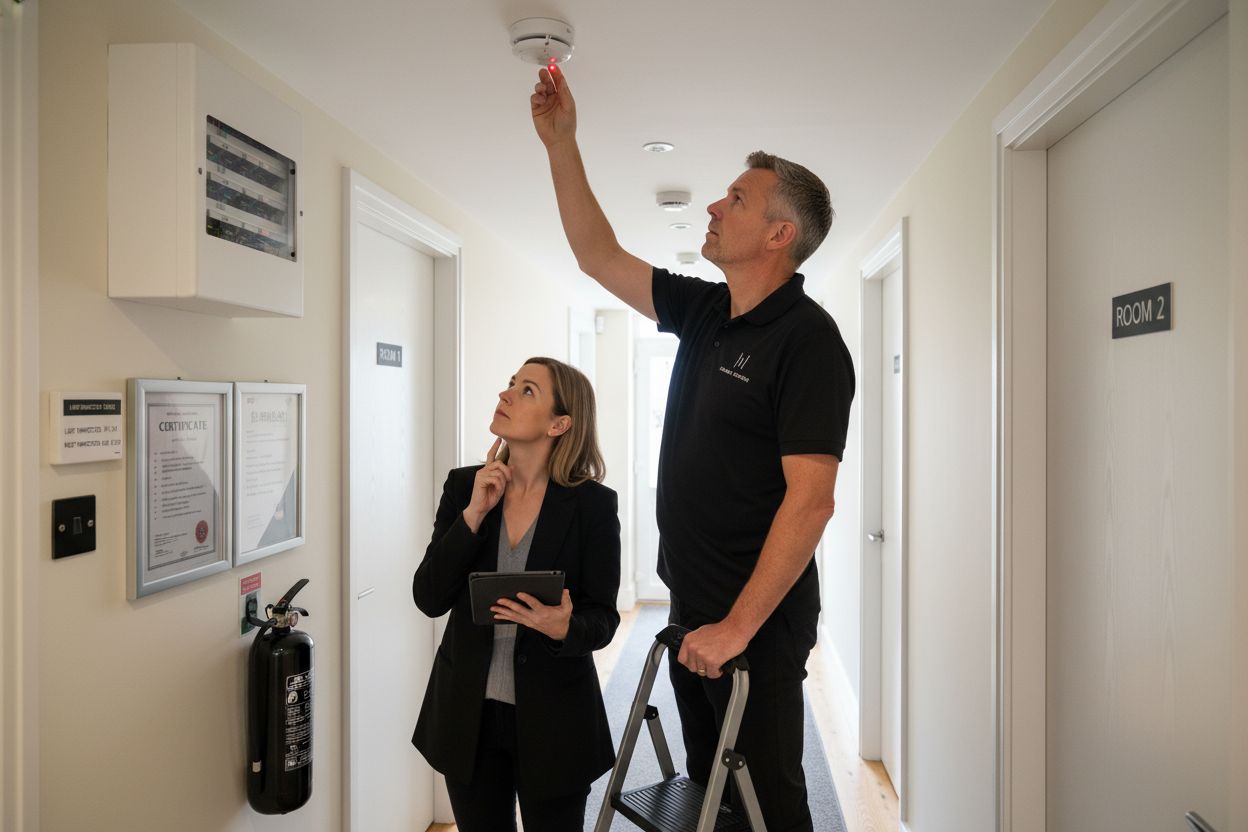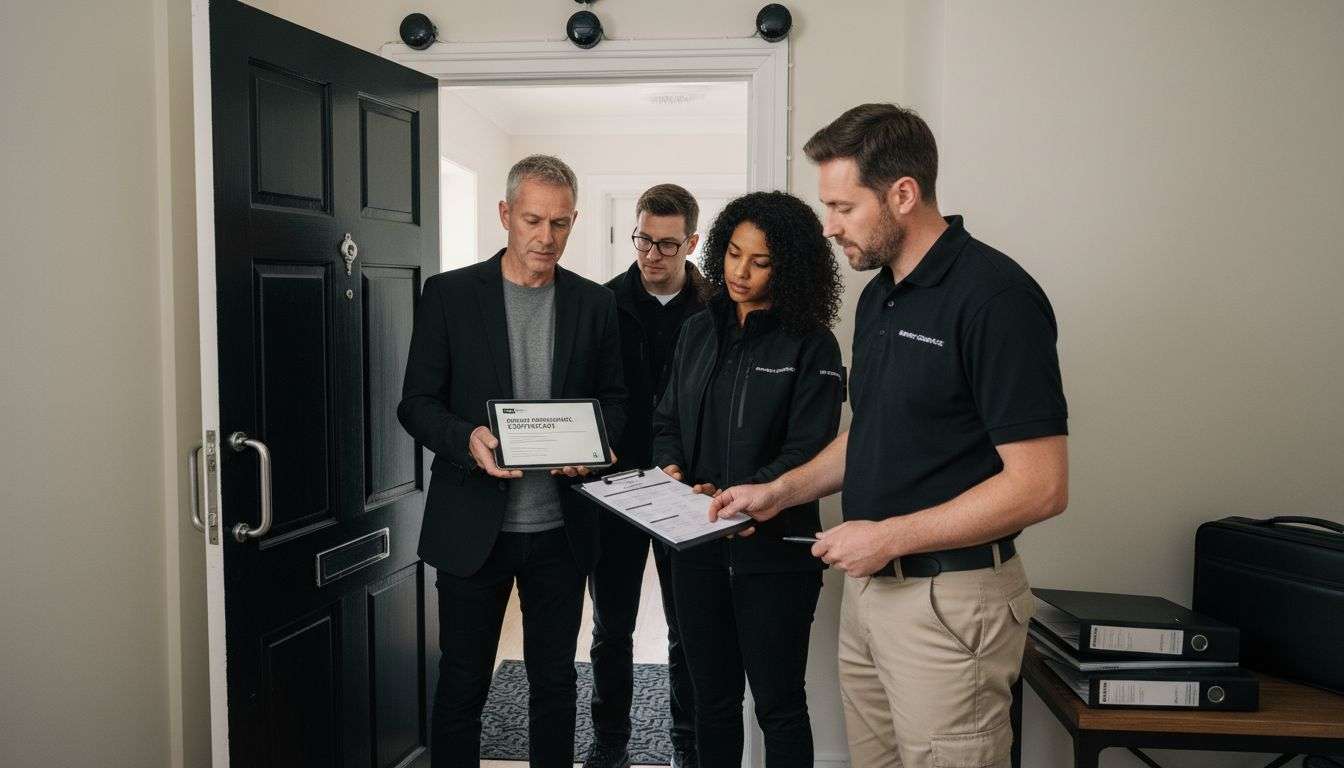Did you know that nearly 500,000 properties in England are classified as HMOs, offering housing to a growing number of renters? Understanding what sets these shared homes apart is crucial for anyone involved in the rental market. As regulations tighten and demand for affordable living rises, knowing the key features and legal definitions of HMOs can help landlords and tenants stay protected and make smarter decisions.
Key Takeaways
| Point | Details |
|---|---|
| HMO Definition | A House in Multiple Occupation (HMO) includes properties occupied by three or more tenants from different households sharing common spaces. |
| Licensing Requirements | Large HMOs with five or more tenants are subject to mandatory licensing, while local councils may impose additional regulations for other types. |
| Safety Compliance | HMO landlords must adhere to rigorous safety standards, including fire safety measures and regular inspections, to ensure tenant protection. |
| Landlord Obligations | Landlords are responsible for obtaining licenses, conducting safety checks, and maintaining habitable conditions, while tenants have defined rights to safety and information. |
Defining HMOs and Key Characteristics
A House in Multiple Occupation (HMO) represents a unique property configuration within the UK residential landscape. According to the Housing Act 2004, an HMO legally exists when a property is occupied by three or more tenants who form two or more separate households and share fundamental living amenities like kitchens, bathrooms, or toilets.
The core characteristics of an HMO include multiple unrelated individuals or groups residing in a single property while sharing essential communal spaces. Understanding HMO Property Management Guide for Investors highlights that these properties must primarily serve as the primary residence for occupants, distinguishing them from temporary accommodation or short-term letting arrangements.
Legal definitions expand beyond simple shared living scenarios. Converted properties where individual flats are not fully self-contained or fail to meet 1991 Building Regulations can also qualify as HMOs if more than one-third of the units are let on short-term bases. This nuanced definition ensures comprehensive coverage of diverse residential scenarios where traditional single-household models do not apply.
Key features that define an HMO typically include:
- Minimum of three tenants from different households
- Shared common areas like kitchens or bathrooms
- Occupants using the property as their primary residence
- Potential requirement for mandatory licensing
For property investors and landlords, understanding these precise definitions is crucial for legal compliance and effective property management.
Types of HMOs and Licensing Requirements
HMOs in the UK are diverse, ranging from small shared houses to complex multi-unit properties. According to local housing authorities, these properties are primarily categorised by two critical factors: occupancy size and shared facility arrangements. Large HMOs, defined as properties housing five or more tenants from two or more households, trigger mandatory licensing requirements.
The licensing landscape is nuanced and can vary significantly by local jurisdiction. 7 Key Types of HMO Licenses You Need to Know highlights that beyond mandatory licensing for large HMOs, local councils may impose additional or selective licensing schemes depending on specific area characteristics and property types.
Typically, HMO types can be broadly classified as:
Here’s a comparison of common HMO types and their typical licensing requirements:
| HMO Type | Occupancy Size | Shared Facilities Required | Licensing Requirement |
|---|---|---|---|
| Small HMO | 3-4 tenants | Yes | Local/Additional (Varies) |
| Large HMO | 5+ tenants | Yes | Mandatory by law |
| Converted Property | Multiple units Not self-contained |
Yes/Partial | Often selective/mandatory |
| Purpose-Built HMO | Varies | Yes | Depends on occupancy size |
- Small HMOs: 3-4 tenants from multiple households
- Large HMOs: 5 or more tenants from multiple households
- Converted Properties: Buildings transformed into multiple living units
- Purpose-Built HMOs: Specifically designed for multi-occupancy
Licensing requirements fundamentally depend on the property’s occupancy and local council regulations. Landlords must obtain mandatory licenses for large HMOs, which involve rigorous property inspections, safety assessments, and compliance checks. Failure to secure appropriate licensing can result in substantial financial penalties and potential legal complications.

Legal Compliance and Safety Standards
HMO management demands rigorous adherence to comprehensive legal and safety requirements that protect both tenants and property owners. According to local housing regulations, landlords must implement multiple critical safety measures to maintain legal compliance and ensure tenant welfare.
HMO Fire Safety Guide: Complete UK Compliance Blueprint emphasizes the importance of proactive safety management. Key compliance standards include functional fire safety systems, regular electrical testing, and annual gas safety checks. These requirements are not optional recommendations but mandatory legal obligations that can result in significant penalties for non-compliance.
Specific legal requirements for HMO safety standards encompass:

- Interlinked smoke alarm systems
- Electrical safety checks every five years
- Annual gas safety certification
- Minimum bedroom size regulations
- Adequate rubbish disposal mechanisms
- Prevention of property overcrowding
- Clear emergency escape routes
Bedroom size regulations are particularly precise: rooms for individuals over 10 years must be at least 6.51 m², shared rooms for two over-10s require 10.22 m², and rooms for under-10s must measure 4.64 m². Landlords must display contact information, maintain communal areas, and ensure structural integrity, with potential prosecution for repeated violations.
Landlord Responsibilities and Tenant Rights
HMO landlords operate within a complex legal framework that balances property management with tenant protections. The relationship between landlords and tenants in Houses in Multiple Occupation is governed by specific statutory requirements that ensure fair, safe, and transparent living arrangements.
8 Essential Tips for Your HMO Legal Checklist 2025 highlights the critical nature of understanding these legal obligations. Landlords must navigate a comprehensive set of responsibilities, including mandatory licensing, safety certifications, and maintaining proper documentation.
Key landlord responsibilities include:
- Obtaining appropriate HMO licensing
- Conducting annual gas safety checks
- Performing electrical safety inspections every five years
- Providing required tenant documentation
- Maintaining structural and health standards
- Protecting tenant deposits
- Respecting proper eviction procedures
Tenant rights are equally well-defined. In HMOs, tenants can expect landlords to maintain shared spaces, handle necessary repairs, and provide written tenancy agreements. They have the right to report non-compliance to local councils and expect safe, habitable living conditions. Most critically, tenants in HMOs are protected from arbitrary eviction and are entitled to receive comprehensive information about their tenancy, including the government’s standardized ‘How to Rent’ guide.
Financial Management, Tax, and Common Pitfalls
Managing an HMO property involves intricate financial considerations that extend far beyond simple rental income collection. Landlords must navigate a complex landscape of tax obligations, insurance requirements, and potential financial risks that can significantly impact their investment strategy.
HMO Legal Checklist 2025 emphasizes the critical importance of comprehensive financial planning. Landlords must meticulously register for tax purposes, declare all rental income, and understand that non-compliance can result in substantial penalties, regardless of their residency status.
Key financial management considerations include:
- Accurate income tax reporting
- Specialized HMO landlord insurance
- Mortgage and property rate management
- Budgeting for maintenance and compliance costs
- Setting appropriate rental rates
- Establishing emergency financial reserves
- Understanding potential Rent Repayment Order (RRO) risks
One of the most significant financial pitfalls involves licensing violations. Tenants and local authorities can issue Rent Repayment Orders through Residential Property Tribunals, potentially forcing landlords to repay up to 12 months of rental income if they operate an unlicensed HMO or breach critical licensing requirements. Proactive financial management and strict adherence to regulatory standards are not just recommended—they’re essential for protecting your investment.
Mastering Your HMO Management Journey with Expert Support
Navigating the complex world of Houses in Multiple Occupation can feel overwhelming with the intricate licensing requirements, strict safety standards, and detailed landlord responsibilities discussed in the Complete Guide to HMO Management in the UK. The challenge of staying fully compliant while maximising your investment returns requires more than just knowledge – it demands the right resources and trusted partners. Whether you are dealing with mandatory licensing, tenant rights, or financial pitfalls like Rent Repayment Orders, the stakes are high and the pressure is real.
Do not let legal complexities or landlord duties hold you back. At AgentHMO, you can access a specialised platform designed to connect you with expert estate agents, accountants, and property managers who understand the unique demands of HMO properties. Benefit from tailored market analytics, reliable financing options, and a comprehensive suite of services that simplify property transactions and ongoing management. Take control today by exploring HMO management solutions that guide you safely through compliance challenges and unlock the full potential of your HMO investments. Visit AgentHMO now and turn your HMO ambitions into success with confidence.
Frequently Asked Questions
What is an HMO?
An HMO, or House in Multiple Occupation, is a property occupied by three or more tenants from different households who share essential living facilities like kitchens and bathrooms.
What are the licensing requirements for HMOs?
Licensing requirements depend on the size and type of the HMO. Large HMOs with five or more tenants require mandatory licensing, while smaller HMOs may need local or additional licenses based on local council regulations.
What safety standards must be met in an HMO?
HMO safety standards include interlinked smoke alarm systems, regular electrical safety checks, annual gas safety certification, and adherence to minimum bedroom size regulations to ensure tenant safety and compliance.
What are the key responsibilities of HMO landlords?
HMO landlords must obtain appropriate licenses, conduct required safety checks, maintain the property, provide necessary tenant documentation, and follow proper eviction procedures to ensure a safe living environment for tenants.



